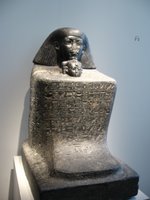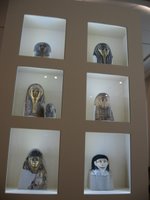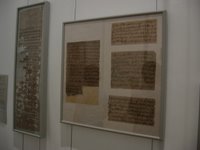Many of you will have some knowledge of the many historical events that have taken place in Berlin, but you may not be aware that Berlin is also a place where one can have a peek into the ancient worlds.
The Museuminsel (Museum Island) in the city centre is home to 5 famous museums that house many ancient collections gathered by German archaeologists at the turn of the 20th century. Among them, the Altes Museum (Old Museum) keeps an extensive collection of ancient Greek and Egyptian artefacts. The Pergamon Museum, on the other hand, keeps many artefacts from ancient civilisations such as Babylon and Islamic countries. More impressively, Pergamon also houses quite a few reconstructed architectural highlights like the Pergamon Altar, Market Gate of Miletus and the Ishtar Gate of Babylon. I was rather impressed by these displays as I have not thought about ancient history for a long time and have never realised how advanced ancient art and architecture are.
There are 3 other museums on the Museum Island, namely the Altes Nationalgalerie (Old National Gallery, not visited this time), Neues Museum (New Museum, under restoration) and the Bode Museum (due to re-open in October 2006). When all the museums are finally open to visitors, history enthusiasts will certainly be more than satisfied. However, I do wonder how much of the artefacts are still left in the countries where they are unearthed, given that many European cities like Munich, Berlin, Paris and Rome all boast a large collection through archaeological digs or military conquests! My Greek friend reassured me that there were still a large amount left in Greece, but I’m not so sure about the other countries!
柏林不平凡的歷史,相信大家都稍知一二,柏林眾多的博物館,則可讓我們窺視更遠古的歷史。
座落於市中心博物館島(Museum Island)的共有五家博物館,蒐集了大量古代文物,由德國考古學家在上世紀初於世界各地發掘,其中遠古博物館(Altes Museum)展出古希臘及古埃及文物,而派嘉蒙博物館(Pergamon Museum)不祇收藏了上古文明(例如巴比倫)及回教國家文物,還把好些古代的建築移師過來重建,包括古希臘的派嘉蒙神殿(Pergamon Altar)、古羅馬的米勒特斯市集城門(Market Gate of Miletus)及巴比倫的依舒塔爾城門(Ishtar Gate)。我很久沒接觸遠古歷史,也沒想到古時的藝術及建築已如此發達,此遊真令我大開眼界。
博物館島還有舊國家藝術館(是次沒參觀)、新藝術館(裝修中)及波德博物館(Bode Museum,十月重開),待所有博物館開放後,必可滿足喜好古物者之眼福了。不過我想,慕尼黑、柏林、巴黎、羅馬及其他歐洲城市已收藏(或掠奪!)了不少文物,那些文物出土國,豈非所剩無幾?我的希臘同事叫我放心,在希臘也可看到不少古希臘文物,但其他國家就未必如此了!
Date of visit: 13 August, 2006 參觀日期:2006年8月13日
Altes Museum 遠古博物館


Helmets (left) and pottery (right) of Ancient Greece
古希臘時之頭盔(左)及瓷器(右)


Ancient Greek gold- and silverware 古希臘時之金銀器



Left: The statue of Praying Boy, which has 'travelled' extensively through many European royal families in the past.
Middle and right: Some Ancient Greek tombstones
左:雕塑「祈禱的男孩」,早年輾轉由不同歐洲皇室收藏
中、右:古希臘墓碑



Statues from Ancient Egypt 古埃及人像



Left: The Bust of Nefertiti; Middle: Various masks; Right: Designs for coffins
左:奈費爾提蒂頭像、中:面具、右:當時棺木的設計


An Ancient Egyptian painting (left) and scroll made of papyrus (right)
古埃及畫(左)及抄在用蘆葦草造的紙的手捲(右)


Artefacts from Ancient Egypt 古埃及文物
Pergamon Museum 派嘉蒙博物館

Queueing in the rain
遊人在雨中排隊


The Pergamon Altar 派嘉蒙神殿

The market of Miletus (in modern Turkey)
米勒特斯市集


The reconstructed Ishtar Gate of Babylon (left) and a model of the city (right)
仿古修建的依舒塔爾城門(左)及古巴比倫模型(右)


Artefacts from other ancient civilisations in the Middle East
來自中東其他古代文明的遺物


Islamic architecture, from Alhambra in Spain (left) and Mshatta Palace near Amman in Jordan (right)
回教建築,左圖來自西班牙Alhambra,右圖來自約旦安曼附近之Mshatta城堡

Need a rug for your place?
你家中要鋪地氈嗎?

An 'all-round' exhibition, about anything circular
伍晃榮展覽,又名「波係圓嘅」(球是圓的)

This butterfly is staring at you!
長了眼睛的蝴蝶翅膀!
The Museuminsel (Museum Island) in the city centre is home to 5 famous museums that house many ancient collections gathered by German archaeologists at the turn of the 20th century. Among them, the Altes Museum (Old Museum) keeps an extensive collection of ancient Greek and Egyptian artefacts. The Pergamon Museum, on the other hand, keeps many artefacts from ancient civilisations such as Babylon and Islamic countries. More impressively, Pergamon also houses quite a few reconstructed architectural highlights like the Pergamon Altar, Market Gate of Miletus and the Ishtar Gate of Babylon. I was rather impressed by these displays as I have not thought about ancient history for a long time and have never realised how advanced ancient art and architecture are.
There are 3 other museums on the Museum Island, namely the Altes Nationalgalerie (Old National Gallery, not visited this time), Neues Museum (New Museum, under restoration) and the Bode Museum (due to re-open in October 2006). When all the museums are finally open to visitors, history enthusiasts will certainly be more than satisfied. However, I do wonder how much of the artefacts are still left in the countries where they are unearthed, given that many European cities like Munich, Berlin, Paris and Rome all boast a large collection through archaeological digs or military conquests! My Greek friend reassured me that there were still a large amount left in Greece, but I’m not so sure about the other countries!
柏林不平凡的歷史,相信大家都稍知一二,柏林眾多的博物館,則可讓我們窺視更遠古的歷史。
座落於市中心博物館島(Museum Island)的共有五家博物館,蒐集了大量古代文物,由德國考古學家在上世紀初於世界各地發掘,其中遠古博物館(Altes Museum)展出古希臘及古埃及文物,而派嘉蒙博物館(Pergamon Museum)不祇收藏了上古文明(例如巴比倫)及回教國家文物,還把好些古代的建築移師過來重建,包括古希臘的派嘉蒙神殿(Pergamon Altar)、古羅馬的米勒特斯市集城門(Market Gate of Miletus)及巴比倫的依舒塔爾城門(Ishtar Gate)。我很久沒接觸遠古歷史,也沒想到古時的藝術及建築已如此發達,此遊真令我大開眼界。
博物館島還有舊國家藝術館(是次沒參觀)、新藝術館(裝修中)及波德博物館(Bode Museum,十月重開),待所有博物館開放後,必可滿足喜好古物者之眼福了。不過我想,慕尼黑、柏林、巴黎、羅馬及其他歐洲城市已收藏(或掠奪!)了不少文物,那些文物出土國,豈非所剩無幾?我的希臘同事叫我放心,在希臘也可看到不少古希臘文物,但其他國家就未必如此了!
Date of visit: 13 August, 2006 參觀日期:2006年8月13日
Altes Museum 遠古博物館


Helmets (left) and pottery (right) of Ancient Greece
古希臘時之頭盔(左)及瓷器(右)


Ancient Greek gold- and silverware 古希臘時之金銀器



Left: The statue of Praying Boy, which has 'travelled' extensively through many European royal families in the past.
Middle and right: Some Ancient Greek tombstones
左:雕塑「祈禱的男孩」,早年輾轉由不同歐洲皇室收藏
中、右:古希臘墓碑



Statues from Ancient Egypt 古埃及人像



Left: The Bust of Nefertiti; Middle: Various masks; Right: Designs for coffins
左:奈費爾提蒂頭像、中:面具、右:當時棺木的設計


An Ancient Egyptian painting (left) and scroll made of papyrus (right)
古埃及畫(左)及抄在用蘆葦草造的紙的手捲(右)


Artefacts from Ancient Egypt 古埃及文物
Pergamon Museum 派嘉蒙博物館

Queueing in the rain
遊人在雨中排隊


The Pergamon Altar 派嘉蒙神殿

The market of Miletus (in modern Turkey)
米勒特斯市集


The reconstructed Ishtar Gate of Babylon (left) and a model of the city (right)
仿古修建的依舒塔爾城門(左)及古巴比倫模型(右)


Artefacts from other ancient civilisations in the Middle East
來自中東其他古代文明的遺物


Islamic architecture, from Alhambra in Spain (left) and Mshatta Palace near Amman in Jordan (right)
回教建築,左圖來自西班牙Alhambra,右圖來自約旦安曼附近之Mshatta城堡

Need a rug for your place?
你家中要鋪地氈嗎?

An 'all-round' exhibition, about anything circular
伍晃榮展覽,又名「波係圓嘅」(球是圓的)

This butterfly is staring at you!
長了眼睛的蝴蝶翅膀!
Comments